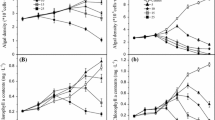Abstract
Flocculation with clays is a promising and environmentally friendly way to remove algal blooms. Physiological responses of Microcystis aeruginosa NIES-843 under the stress of chitosan modified kaolinite (CMK) loading were first reported in this paper. Compared with the control, the contents of chlorophyll a (Chl a) and carotenoids showed no significant difference at a CMK loading of 40 mg/l, but the phycocyanin content was significant lower than the control at this loading level. The contents of Chl a, carotenoids, phycocyanin and allophycocyanin were all significantly lower than the control at 80 and 160 mg/l CMK, and the leakage of phycobilins occurred at these two loading levels suggesting that flocculation with CMK could cause the damage of cellular membranes. The activities of extracellular alkaline phosphatase activity (E-APA), superoxide dismutase (SOD) and catalase (CAT) were all dramatically boosted under the stress of CMK loading. The changes of cellular dehydrogenase activity exhibited the same trends as of Chl a and carotenoids, and it decreased to the levels of lower than detectable limits on 12 and 8th day at a CMK loading of 80 and 160 mg/l, respectively. These results indicated that flocculation with CMK could cause cell mortality of M. aeruginosa.








Similar content being viewed by others
References
Abelson JN, Simon MI (1988) Phycobiliproteins in cyanobacteria. In: Lester P, Alexander NG (eds) Method in Enzymology. Academic Press Inc, London, p 167
Anderson DM (1997) Turning back the harmful red tides. Nature 38:513–514
Azevedo SM, Carmichael WW, Jochimsen EM et al (2002) Human intoxication by microcystins during renal dialysis treatment in Caruaru, Brazil. Toxicology 181–182:441–446
Bae HM, Choi HG, Lee WC et al. (1998) Control of the red tide by yellow loess dispersion. In Proceedings of the Korea-China Joint Symposium on Harmful Algal Blooms, Chinese Academy of fisheries science, Pusan, pp 53–60
Beauchamp C, Frodovich I (1971) Superoxide dismutase: improved assays and an assays applicable acrylamide gels. Anal Biochem 44:276–287
Bradford M (1976) A rapid and sensitive method for the quantification of microgram quantities of protein utilizing the principle of protein-dye binding. Anal Biochem 72:248–254
Cao X, Song C, Zhou Y (2010) Limitations of using extracellular alkaline phosphatase activities as a general indicator for describing P deficiency of phytoplankton in Chinese shallow lakes. J Appl Phycol 22:33–41
Chen CL (2000) Determination of activity in roots. In: Li HS (ed) Principles and methods for the physiological and biochemical experiments of plant. Higher education Press, Beijing, pp 119–120
Choo KS, Snoeijs P, Pedersen M (2004) Oxidative stress tolerance in the filamentous green algae Cladophora glomerata and Enteromorpha ahlneriana. J Exp Mar Biol Ecol 298:111–123
Frank HA, Cogdell RJ (1996) Carotenoids in photosynthesis. Photochem Photobiol 63:257–264
Jung HS, Niyogi KK (2008) Molecular analysis of photoprotection of photosynthesis. In: Demmig-Adams B, Adams WW, Mattoo AK (eds) Advances in photosynthesis and respiration: photoprotection, photoinhibition, gene regulation, and environment. Springlink, Netherlands, pp 127–143
Kromkamp J, Van Den Heuvel A, Mur LR (1989) Phosphorus uptake and photosynthesis by phosphate-limited cultures of the cyanobacterium Microcystis aeruginosa. Eur J Phycol 24:347–355
Liu G, Fan C, Zhong J et al (2010a) Using hexadecyl trimethyl ammonium bromide (CTAB) modified clays to clean the Microcystis aeruginosa blooms in Lake Taihu, China. Harmful Algae 9:413–418
Liu L, Chen B, Wang Z (2010b) Flocculation and removal of algae in algal-bloom water by chitosan-modified clays. Chinese J Environ Eng 4:1296–1300
Mulholland MR, Floge S, Carpenter EJ et al (2002) Phosphorus dynamics in cultures and natural populations of Trichodesmium spp. Mar Ecol Prog Ser 239:45–55
Muljadi D, Posner AM, Quirk JP (1966) The mechanism of phosphate adsorption by kaolinite, gibbsite, and pseudoboehmite. J Soil Sci 17:212–228
Pan G, Zhang MM, Chen H et al (2006a) Removal of cyanobacterial blooms in Taihu Lake using local soils I. Equilibrium and kinetic screening on the flocculation of Microcystis aeruginosa using commercially available clays and minerals. Environ Pollut 141:195–200
Pan G, Zou H, Chen H et al (2006b) Removal of harmful cyanobacterial blooms in Taihu Lake using local soils III. Factors affecting the removal efficiency and an in situ field experiment using chitosan-modified local soils. Environ Pollut 141:206–212
Panigrahi S, Padhy S, Padhy RN (2003) Toxicity of parathion-methyl to cells, akinetes and heterocysts of the cyanobacterium Cylindrospermum, sp. and the probit analysis of toxicity. Ann Appl Biol 143:195–202
Richards FA, Thompson TG (1952) The estimation and characterization of plankton populations by pigment analyses II. A spectrophotometric method for the estimation of plankton pigments. J Marine Res 11:156–172
Rippka R, Desrulles J, Waterbury JB et al (1979) Generic assignment, strain histories and properties of pure cultures of cyanobacteria. J Gen Microbiol 11:1–61
Sengco MR (2001) The aggregation of clay minerals and marine microalgal cells: physicochemical theory and implications for controlling harmful algal blooms. PhD thesis, Massachusetts Inst Technol at Woods Hole Oceanographic Institution, Woods Hole, pp 61–63
Shirota A (1989) Red tide problem and countermeasures. Int J Aquat Fish Technoi 1:195–223
Shiu CT, Lee TM (2005) Ultraviolet-B-induced oxidative stress and responses of the ascorbate–glutathione cycle in a marine macroalga Ulva fasciata. J Exp Bot 56:2851–2865
Valentine JS, Wertz DL, Lyons TJ et al (1998) The dark side of dioxygen biochemistry. Curr Opin Chem Biol 2:253–262
Zamocky M, Furtmuller PG, Obinger C (2008) Evolution of catalases from bacteria to humans. Antioxid Redox Signal 10:1527–1548
Zou H, Pan G, Chen H et al (2006) Removal of cyanobacterial blooms in Taihu Lake using local soils II. Effective removal of Microcystis aeruginosa using local soils and sediments modified by chitosan. Environ Pollut 141:201–205
Acknowledgments
The research was supported by National Water Science and Technology Projects (2009ZX07101-013-02), Hunan Provincial Natural Science Foundation of China (10JJ6045) and National Natural Science Foundation of China (NO. 21107024).
Author information
Authors and Affiliations
Corresponding author
Rights and permissions
About this article
Cite this article
Shao, J., Wang, Z., Liu, Y. et al. Physiological responses of Microcystis aeruginosa NIES-843 (cyanobacterium) under the stress of chitosan modified kaolinite (CMK) loading. Ecotoxicology 21, 698–704 (2012). https://doi.org/10.1007/s10646-011-0828-5
Accepted:
Published:
Issue Date:
DOI: https://doi.org/10.1007/s10646-011-0828-5




